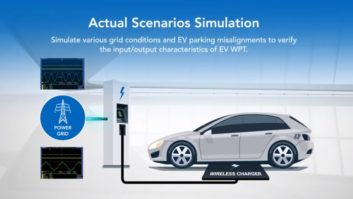The author is the owner of Keener Technical Services.
On Feb. 20, 2014, federal regulation 47 CFR §1.30000 became effective. That regulation and date could be important to some broadcasters.
If you own an AM license or work on the technical side at an AM radio station, you may have heard about this but not really been told much about it. What we’re talking about here is what the folks who erect and modify communications towers, usually cellular support towers, have to do to protect your pattern from distortion.

The new rules wiped out the old ones, scattered over various parts of the regulations. So you can forget everything you thought you knew about this. Some commenters have lamented this change, but to no avail, I fear. Uncle Sam has made up his mind.
The rules require action on the part of the tower owner or wireless carrier only if what they’re planning to do is build a new tower or install a “significant modification.” What’s that? Any change in height of 5 electrical degrees or more, or any modification on a tower that is detuned or base-insulated, is considered “significant.” I’ve never seen a cell tower on a base insulator, but it’s probably out there. Remember that they said a change of 5 or more electrical degrees; they didn’t specify positive or negative. In some situations, shortening an existing tower could change the re-radiation characteristics enough to cause monitor points to go out.
KEEP YOUR DISTANCE
What about distance? For non-directional stations, the coordination distance is defined as “within one wavelength;” for directional stations it’s “within” the lesser of 10 wavelengths or 3 kilometers. We think that means a distance equal to or less than the distance stated, but consult your communications attorney. Note that their definition of wavelength is stated in 47 CFR §1.30001(a), and is derived by dividing 300 by the carrier frequency in megahertz. This assumes that the velocity of propagation here on planet Earth is identical to free space, but hey, what the heck … At least we won’t be arguing about velocity conversion factors.
Under the new regulations, the electrical height of the structure is also a coordination factor. Heights “taller than” 60 electrical degrees for non-directional and 36 electrical degrees for directional stations coordinate positively. So if the offending tower near your flamethrower on 1230 kHz is exactly 60 electrical degrees tall, it’s too short. Knowing the actual physical height of these towers is now more important than ever.
WHY IT’S IMPORTANT
What does this all mean to the broadcaster?
The new rules don’t require the tower owner or licensee to do anything if a change is not defined as a new tower or a significant modification of an existing one.

If it is so defined but the structure is too short or too far away (either or both), the tower owner still doesn’t have to do anything. They don’t even have to notify you.
If the change is defined as a new tower build or significant modification and it is within the height and distance coordination criteria, they have to notify you and conduct a method-of-moments analysis of the predicted impact of the structure.
If your station is non-directional and the predicted distortion is greater than 2 dB, they must apply detuning.
If your station is directional and any distortion is predicted that would cause the standard or augmented pattern values to be exceeded at all, anywhere, the tower must be detuned.
Of course, if it’s not a new tower and it’s a significant modification, it must already be detuned, unless the change is a height change.
Directional stations with a traditional proof can substitute pre- and post-construction measurements at the monitor points for the method-of-moments analysis. This might be an important detail in certain situations.
Let’s suppose you have a tower near your directional array that’s just within coordination distance, it’s not detuned and it’s 36.1 electrical degrees tall. This tower has never really been a problem to you, but you’ve known about it for years.
Now the owner wants to increase the height by 5 electrical degrees to install a bracket for a new collocation. This would be a significant modification. You will be notified.
They will run the method-of-moments study, and it will return a prediction that your pattern will be distorted enough to cause it to exceed the licensed values somewhere. It will because any study we’ve seen causes some ripple. The rule says, in effect “no ripple.”
They will be forced to apply detuning to a tower that, even with that small increase, still would not be a new problem for your pattern. If your array was proofed using field intensity measurements and that tower was present then and not detuned, the installation of detuning might or might not cause your pattern to go out. If it does, what do you do? You could ask them to measure the monitor points in lieu of the method-of-moments analysis. If all the intensity measurements were within the FCC limits (or the post-modification measurements did not increase any of the values if your pattern was already out of adjustment), then you could both avoid having to apply detuning. You could also avoid possibly having to adjust the array (and maybe having to complete a partial proof). If your station has a method-of-moments proof, you’re stuck with the method-of-moments analysis and the detuning.
Of course, the reason you wanted to file a method-of-moments proof was to avoid having monitor points in the first place.
DETUNING DETAILS
What if you have a detuned tower that’s just within coordination distance relative to your array and it is 36 electrical degrees tall? You’re going to get ignored, right?
No. Our customers seem to understand that any detuned tower should be treated as an ongoing problem for them, regardless of the new regulation, and that the detuning needs to be maintained through these repetitive installations. This should include some kind of pattern measurements made before and after modification, in addition to suppression measurements made on the detune itself. Since they no longer have to pay for endless measurements due to modifications made on non-detuned towers, wireless telcos and structure owners are in a mood to pay a little more to make sure the problems that might be left over from the old regulations stay under control.
The new regulation also gives broadcasters another tool to manage situations. That’s 47 CFR §1.30002 (g), what we call the “notwithstanding clause.”
For new construction or modifications that went up after the effective date of the new rules, your station can show impact by presenting either a method-of-moments study or field intensity measurements, even if the structure is outside the coordination criteria. This needs to be sent to both the tower owner/proponent and the FCC. The government will give you two years from the date of completion to speak up. After that, they will ignore you. For construction “commenced or completed” prior to or on the effective date of the new rules, you have until Feb. 20, 2015 to file your complaint; see 47 CFR §1.30002 (h). That festering problem you’ve had? It’s now or never. After the cutoff date, you’ll be stuck with your situation as far as the FCC is concerned.
Should you complain to the FCC about a problem tower? Yes, but only if you’ve already approached the tower owner, proponent or carrier about a situation multiple times and gotten nowhere.
The government is very slow to act, and the only weapon they seem to have in their arsenal is detuning. The very last thing you want in your picture is a detuning kit, unless there’s just no other choice. Detuning is fragile and has to be constantly monitored for the effects of weathering and human activities on the tower. But of course, no one at our end has the resources to do that. We discover problems when we visit the sites or when a broadcaster complains. If you complain to the tower owner, you should get action. That’s why owners and carriers have vendors like us around, to put out “fires” in the AM regulatory world.
Gary O. Keener has been a broadcast engineer and a consultant to both the broadcast and cellular industries for many years. Contact him at [email protected].












